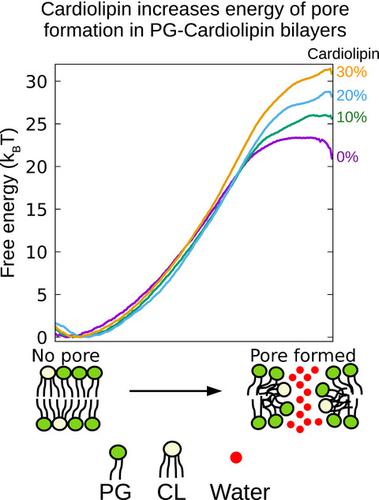当前位置:
X-MOL 学术
›
FEBS Lett.
›
论文详情
Our official English website, www.x-mol.net, welcomes your
feedback! (Note: you will need to create a separate account there.)
Cardiolipin prevents pore formation in phosphatidylglycerol bacterial membrane models
FEBS Letters ( IF 3.0 ) Pub Date : 2021-10-11 , DOI: 10.1002/1873-3468.14206 Cristian Rocha-Roa 1 , Juan David Orjuela 2, 3 , Chad Leidy 4 , Pilar Cossio 1, 5 , Camilo Aponte-Santamaría 2
FEBS Letters ( IF 3.0 ) Pub Date : 2021-10-11 , DOI: 10.1002/1873-3468.14206 Cristian Rocha-Roa 1 , Juan David Orjuela 2, 3 , Chad Leidy 4 , Pilar Cossio 1, 5 , Camilo Aponte-Santamaría 2
Affiliation

|
Several antimicrobial peptides, including magainin and the human cathelicidin LL-37, act by forming pores in bacterial membranes. Bacteria such as Staphylococcus aureus modify their membrane's cardiolipin composition to resist such types of perturbations that compromise their membrane stability. Here, we used molecular dynamic simulations to quantify the role of cardiolipin on the formation of pores in simple bacterial-like membrane models composed of phosphatidylglycerol and cardiolipin mixtures. Cardiolipin modified the structure and ordering of the lipid bilayer, making it less susceptible to mechanical changes. Accordingly, the free-energy barrier for the formation of a transmembrane pore and its kinetic instability augmented by increasing the cardiolipin concentration. This is attributed to the unfavorable positioning of cardiolipin near the formed pore, due to its small polar head and bulky hydrophobic body. Overall, our study demonstrates how cardiolipin prevents membrane-pore formation and this constitutes a plausible mechanism used by bacteria to act against stress perturbations and, thereby, gain resistance to antimicrobial agents.
中文翻译:

心磷脂防止磷脂酰甘油细菌膜模型中孔的形成
几种抗菌肽,包括马加宁和人抗菌肽 LL-37,通过在细菌膜上形成孔来发挥作用。金黄色葡萄球菌等细菌会改变其膜的心磷脂成分,以抵抗损害其膜稳定性的此类扰动。在这里,我们使用分子动力学模拟来量化心磷脂对由磷脂酰甘油和心磷脂混合物组成的简单细菌样膜模型中孔形成的作用。心磷脂改变了脂质双层的结构和排序,使其不易受到机械变化的影响。因此,通过增加心磷脂浓度,可以增强跨膜孔形成的自由能垒及其动力学不稳定性。这是由于心磷脂的极性头小和疏水体大,因此在形成的孔附近处于不利的位置。总体而言,我们的研究证明了心磷脂如何防止膜孔形成,这构成了细菌用来对抗应激扰动的合理机制,从而获得对抗菌药物的耐药性。
更新日期:2021-11-08
中文翻译:

心磷脂防止磷脂酰甘油细菌膜模型中孔的形成
几种抗菌肽,包括马加宁和人抗菌肽 LL-37,通过在细菌膜上形成孔来发挥作用。金黄色葡萄球菌等细菌会改变其膜的心磷脂成分,以抵抗损害其膜稳定性的此类扰动。在这里,我们使用分子动力学模拟来量化心磷脂对由磷脂酰甘油和心磷脂混合物组成的简单细菌样膜模型中孔形成的作用。心磷脂改变了脂质双层的结构和排序,使其不易受到机械变化的影响。因此,通过增加心磷脂浓度,可以增强跨膜孔形成的自由能垒及其动力学不稳定性。这是由于心磷脂的极性头小和疏水体大,因此在形成的孔附近处于不利的位置。总体而言,我们的研究证明了心磷脂如何防止膜孔形成,这构成了细菌用来对抗应激扰动的合理机制,从而获得对抗菌药物的耐药性。











































 京公网安备 11010802027423号
京公网安备 11010802027423号